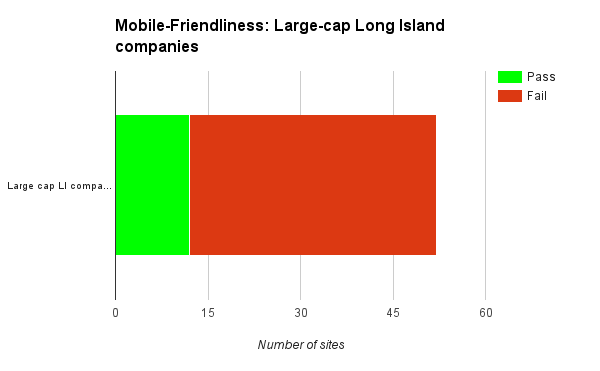April 6, 2015: Over the past several weeks, Didit has been analyzing sites in many different business verticals to assess their mobile-friendliness as the 4/21 “mobilegeddon” date looms across the nation.
Last week, we looked at large PR firms across the U.S. and found that only 57.3 percent of them were considered “mobile-friendly” according to Google’s test. Today we look at large-cap Long Island companies. Unfortunately, the performance was much worse than we expected (only 22 percent of the sites we tested passed Google’s Mobile-Friendly test with flying colors).
Methodology
Didit ran each large-cap site through Google’s Mobile Friendly Test application page (https://www.google.com/webmasters/tools/mobile-friendly/) to see whether Google considers each site “mobile-friendly.” The error types causing any test failures were logged, and a screen capture was made of each report.
Here is a summary of findings:
1. 22 percent (12) of the 53 large-cap LI firms surveyed are fully “mobile-friendly” according to Google’s definition.
2. The most common errors seen on the 41 sites failing Google’s Mobile Friendly test were:
a) Links spaced too closely together to be easily clicked on mobile devices. 40 failing sites had this error.
b) Mobile viewports not being set correctly. This error can cause the site to render in less than 100 percent of mobile display space. 36 failing sites had this error
c) Text being set at a size too small to read on mobile devices. 35 failing sites had this error
d) Blocking of resources necessary for the Googlebot to correctly parse the resources referenced by the web page. 25 failing sites had this error.
e) Content wider than screen. This error causes parts of the right area of the screen to become invisible on mobile devices. 18 failing sites had this error.
Analysis
The fact that a given corporate site has failed Google’s Mobile Friendly Test does not mean that it cannot be accessed on mobile devices. But Google has indicated that poor showings on this test may result in less visibility in search results made from mobile devices. This is obviously a concern as mobile traffic — and searches made on mobile devices — grow in importance. According to Emarketer.com, “2015 will see mobile search reach the tipping point — the stage at which the majority of spend, organic traffic, and paid clicks comes form smartphones and tablets.” (See: http://www.emarketer.com/Article/Mobile-Search-Will-Surpass-Desktop-2015/1011657)
While our findings should be cause for concern, there is no need for corporate management to panic. In most cases the problems causing a “Fail” on Google’s Mobile Test can be easily solved, by unblocking resources for Google’s robots and by deploying responsive themes that render equally well on all devices. But the proprietors of very old sites that were built years ago (before smart phone access was a factor) may have to do some major “heavy lifting” to bring their sites into compliance. This work should be started now, because there “mobilegeddon” is just two weeks away.
Senior management needs to take this issue seriously. It should direct IT teams to immediately evaluate their sites’ mobile friendliness, and, if there’s a problem, ensure that all corrections are made in time. Google Webmaster Tools provides additional resources to help these teams identify and eliminate any such problems.
- 10 Mistakes to Avoid When Using QR Codes for Marketing - September 20, 2023
- Kevin Lee on How AI Changes the SEO Landscape - August 31, 2023
- The Power of Compound Marketing: Kevin Lee Presents @ 1MediaWorld 2023 Global Conference - March 7, 2023



